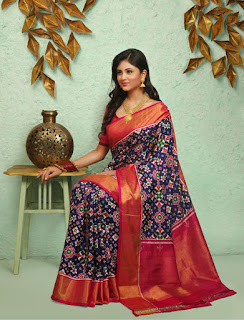Neatly tucked in the interiors of Gujarat is the unassuming town of Patan. Standing amid the ruins of the once-powerful Solanki dynasty that reigned between the 10th and 13th centuries, the town is popular for‘Rani-ki-vav’, a well-preserved stepwell that is a UNESCO World Heritage site and the most exquisite silken weave of the patola textile. A heritage of the Salvi family that has kept the centuries’ old art of double ikat patola sarees thriving till today, the GI registered Patan patola is rather unique.
The popularity and desirability of Patan Patola by any Gujarati woman can be gauged in the melodious Gujarati folk song “Chhelaji re mare hatu Patanthi patola, mongha lavjo ema ruda re moraliya chitravjo Patanthi patola” (a woman urges her husband who is off to Patan to bring her the coveted patola saree from there), penned by the noted Gujarati poet Avinash Vyas decades ago.
Worn by royals and aristocrats on auspicious occasions, and prized as a holy cloth even in South-east Asia, the patola finds mention in the 14th century travel accounts of Ibn Batuta, who gifted patolas to kings. Indonesia was the largest importer of Patan patola before World War II. It was a matter of great pride for Gujarati brides to have it as part of their wedding trousseau. Communities such as Nagar Brahmins and Kutchi Bhatia used patola as a ceremonial cloth.
The Salvi family of Patola has carried forward this heritage art since the 11th century over roughly 35 generations. They trace their origin to the patola weavers of Jalna (Maharashtra). It is said that the king Kumarpal of the Solanki dynasty highly valued the patola and bought it from Jalna. But when he learnt that the king of Jalna used them first as bed-sheets before allowing the weavers to sell them, Kumarpal invited 700 families of Jain Salvi weavers to settle down in Patan in the 12th century.
Patan Patola sarees till date are woven on primitive hand-operated harness loom made of sturdy teakwood. The painstaking traditional process of spinning, tying-dyeing and weaving takes four or more weavers four to eight months to weave a piece.The mulberry silk used in making of these sarees is still imported from China.
The specialty of double ikat weaving is that each warp and weft thread is tied separately with a cotton string to colour by a tie-dye technique (bandhani process). The pattern becomes apparent as warp threads start setting on the loom.The resultant patola silk has no reverse side as both the sides have equal intensities of colour and design.
Loud red, yellow, green and blue dominate the saree. These striking colours remain intact for centuries as the Salvi family ensures that all colours are sourced organically. Turmeric, marigold flowers, onion skin, pomegranate bark, madder root, lac, catechu and indigo along with different mordant (use of chemicals to bind natural dyes to the textile fibres) are used as dye.
Floral motifs, animals, birds and human figures are basic designs, but geometrical patterns are most popular. Traditional motifs are called bhat and include narikunjar, paan, choktha (square), chhabadi (10 elephants), laheriya (diagonal lines) and navratna (nine gems) among others.
Narikunjar is the most traditional bhat and remains the most popular. shrikarbhat depicts elaborate hunting scene with animal motifs like ornate elephants.
While single ikat weaving spans many countries, the double ikat textiles are made only in four places in the world Bali (Indonesia), Okinawa island (Japan), Pochampalli (Telangana) and Patan in Gujarat. Rarest of the rare, Double ikat Patolas from Patan are the most colorful and most intricate of all.

No comments:
Post a Comment